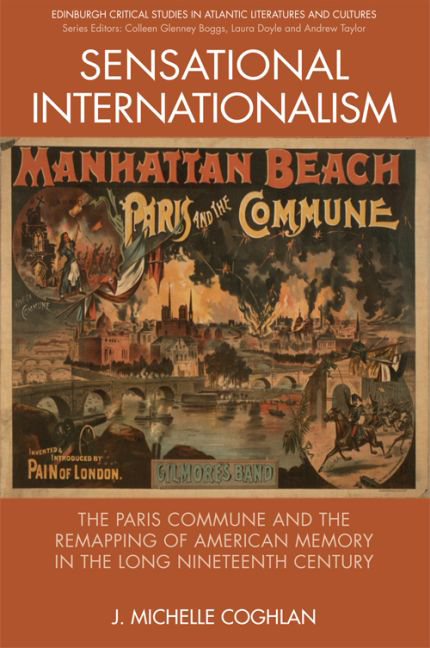 Sensational Internationalism
Sensational Internationalism Book contents
- Frontmatter
- Contents
- List of Illustrations
- Acknowledgments
- Series Editors’ Preface
- Introduction: Revolutionary Preoccupations: Or, Transatlantic Feeling in a Radical Sense
- 1 Framing the Pétroleuse: Postbellum Poetry and the Visual Culture of Gender Panic
- 2 Becoming Americans in Paris: The Commune as Frontier in Turn-of-the-Century Adventure Fiction
- 3 Radical Calendars: The Commune Rising in Postbellum Internationalism
- 4 Tasting Space: Sights of the Commune in Henry James's Paris
- 5 Restaging Horror: Insurgent Memories of the Commune in the 1930s
- Epilogue: Barricades Revisited – The Commune on Campus from FSM to SDS
- Notes
- Bibliography
- Index
4 - Tasting Space: Sights of the Commune in Henry James's Paris
- Frontmatter
- Contents
- List of Illustrations
- Acknowledgments
- Series Editors’ Preface
- Introduction: Revolutionary Preoccupations: Or, Transatlantic Feeling in a Radical Sense
- 1 Framing the Pétroleuse: Postbellum Poetry and the Visual Culture of Gender Panic
- 2 Becoming Americans in Paris: The Commune as Frontier in Turn-of-the-Century Adventure Fiction
- 3 Radical Calendars: The Commune Rising in Postbellum Internationalism
- 4 Tasting Space: Sights of the Commune in Henry James's Paris
- 5 Restaging Horror: Insurgent Memories of the Commune in the 1930s
- Epilogue: Barricades Revisited – The Commune on Campus from FSM to SDS
- Notes
- Bibliography
- Index
Summary
Not that an urban vista is quite the same as a loved face, but it isn't quite different, either: the despoiled view was suddenly a toothless face, say, or suddenly preoccupied, or suddenly dead – to say nothing, even, of the historical implications surrounding that particular change of landscape.
Eve Sedgwick, Touching FeelingWhat would it mean not to see the remainders of history as they are writ in space, but rather to taste them? To smell buried pasts simmering below the otherwise glassy surface of a cityscape? And finally, to possess – and be possessed by – pasts that did not, in any real sense, belong to us?
At least since what Bill Brown has termed its “literary-critical apotheosis” in the 1990s, The American Scene has been the privileged site to examine Henry James's fascination with – and affective responses to – lost landmarks and “instant” ruins, landscapes of loss that have come, in turn, to stand in for modernity, American-style. While Brown has suggested that “the most unnerving aspect of The American Scene is the volubility of its buildings,” I would add it is also James's response to them. For such affecting and untimely absences – in particular, the “ruthlessly suppressed birth-house” in Washington Square and the unexpectedly vanished home in Ashburton Place – register for James as tourist sights quite literally felt as much as seen (or, for that matter, heard). In the section entitled “The Lost Chord,” he writes of the disappearance of his Cambridge home, for example:
I had been present, by the oddest hazard, at the very last moments of the victim in whom I was most interested; the act of obliteration had been swift, and if I had often seen how swiftly history could be made I had doubtless never so felt that it could be unmade still faster. It was as if the bottom had fallen out of one's own biography, and one plunged backward into space without meeting anything.
And as urban historian Nick Yablon has suggested, James “feels these architectural losses so intensely and personally [that] they linger on his mental map of the metropolis as absent presences, phantom limbs representing a history ‘amputated’ from him.”
- Type
- Chapter
- Information
- Sensational InternationalismThe Paris Commune and the Remapping of American Memory in the Long Nineteenth Century, pp. 105 - 129Publisher: Edinburgh University PressPrint publication year: 2016


